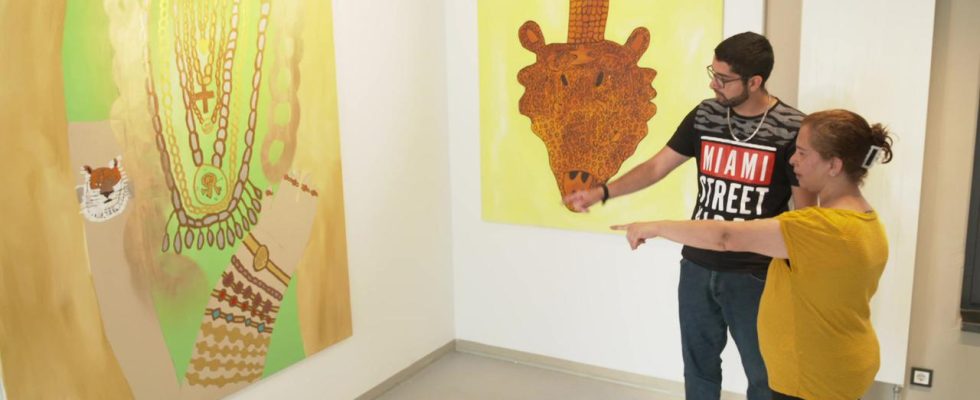In the middle
Artists who have disabilities work at the kaethe:k Kunsthaus in Pulheim. Art educators and social workers help them to develop – as people and in their art.
Firat Tagal moves his brush across the canvas with quick, decisive movements. Below he painted a large blue area, a swimming pool. Slides appear above, in bright yellow and orange. It’s a water park in Turkey, says the 26-year-old.
Tagal prefers to express himself through painting rather than big words. But if you ask him about his profession, the answer comes straight away: “I’m an artist. I paint very large, with acrylic paint. I also mix the colors myself.”
Hidden talents
Melanie Schmitt immediately noticed that Tagal had a special artistic talent. She directs the kaethe:k Kunsthaus, which opened in Pulheim near Cologne in 2020. It is a studio for artistically gifted people with disabilities. It is supported by the Gold-Krämer-Stiftung, which is known for its inclusive projects.
“Firat was one of the first applicants to take part in our workshops. His art teacher told him about us. He applied for a job with us with a few small drawings and already in the first workshop he noticed huge papers on the wall drawn. That was an absolute wow factor for us,” says Schmitt.
Tagal carried his talent like a secret. Before he came to kaethe:k, he worked in a workshop for the disabled. Today, three years later, he proudly talks about his exhibitions as a solo artist. He has also sold works.
Firat Tagal’s artistic talent remained undiscovered for a long time.
“I never had a chance to prove myself”
Finding and promoting talent, not only in their art, but also as people – that’s what the team of art and social educators at the Pulheimer Kunsthaus is all about. Twelve artists are currently working here, spread over three floors. Almost all of them attended a special school and then worked in workshops for the disabled or in unskilled labor jobs.
It was the same with Elias von Martial. The 27-year-old cleaned trucks in a workshop after special school. Today he learns complex animation programs and takes courses at an art college.
The kaethe:k has completely changed him as a person, he says. “I never had a chance to prove that I could do it. All my life I was put somewhere I didn’t really want to be. I was always told: You can’t do it, don’t even try it. But here it is “It’s completely different,” says von Martial. In the three years he has been working at the Kunsthaus, he has become more mature and self-confident.
Elias von Martial: “I never had a chance to prove that I could do that.”
Network for artists with disabilities
On the day of the open studio, he is the one who leads the approximately 40 visitors through the art house and interviews the other artists about their work. This is also part of the kaethe:k program: the talented women and men, most of whom are in their twenties, will be networked with the art and cultural scene when they are ready.
“We are still far from being at a point where it is a matter of course that people with disabilities become artists and cultural workers. That is why the kaethe:k Kunsthaus, along with several other studios in Germany, is already a special institution,” says director Schmitt , which previously helped set up a similar project in Frankfurt am Main.
What drives them is above all the rapid development of the artists – in their personality and in their work. “People are transforming. And we see art being created here that people love, that they want to see. We think that society is missing something if it doesn’t look at it.”
Potential is in the foreground
Which path they take is completely up to the artists at kaethe:k. Elias von Martial would like to become an animation artist and at some point work on feature films, preferably in the fantasy sector.
Firat Tagal wants to make a career as a painter. His journey is a big surprise for his family, says his mother Gülüzar Tagal: “I’m really proud of my son, he’s hard-working, he works well. And above all, he’s talented, which I wouldn’t have known as a layman. The experts figured it out and I’m very happy we ended up here.”
What disability the artists have is not the focus. Most of them have circled around their deficits long enough, Schmitt thinks. Now their potential is in the foreground.

